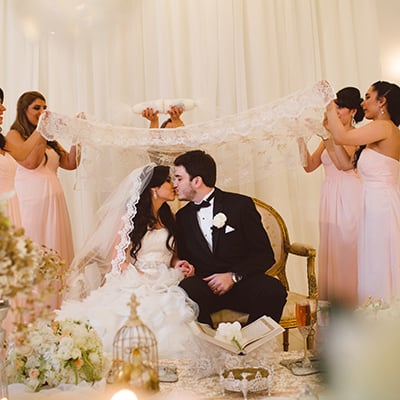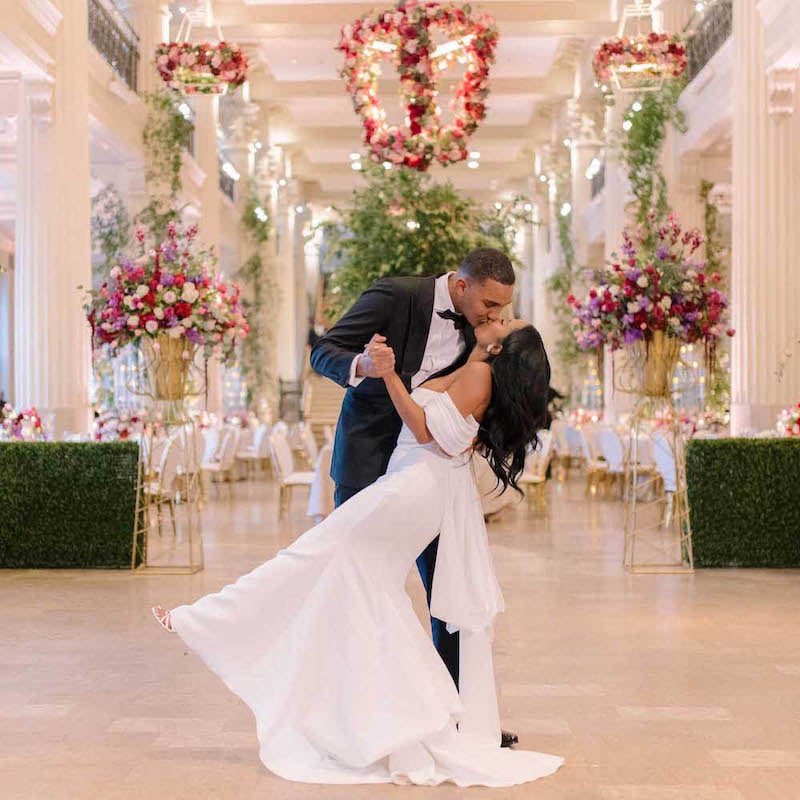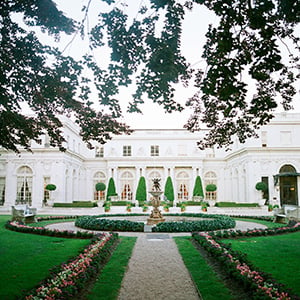Rites + Rituals

Photo: M. Wang for J. Cogliandro Photography
First comes love, then comes marriage…then comes the celebration. In all the excitement and planning and prettifying of the wedding reception—likely the most elaborate party of your life—the significance of the marriage ceremony can sometimes get…sidelined. But the sanctification of your marriage vow is the very heart of your wedding. It is, indeed, your one chance to express your love and commitment in the most personal way possible. Give it its due, with a ceremony that speaks your deepest emotions, embraces your family and friends, and seals the bond of love, now and forever.
Timeless Traditions
When it comes to enduring marriage rituals, “Hand-fasting is a great alternative for the couple looking for meaningful and spiritual vows, without bordering on a religious note,” says Claudia De Velasco, owner of planning firm A Day To Remember. “Customizing the ribbons or the rope for the hand-fasting is part of the fun, such as using heirloom pieces of fabric.”
Aliah Calbert, owner of Calberts Weddings & Events, says, “‘Jumping the broom’ is one of my favorite parts of a wedding.” The African ritual, where the couple steps or jumps together over a broom laid out on the ground before them, shows respect and pays homage to ancestors who came before the couple and paved their way. It also “shows the couple is leaving the past and jumping into the future,” Calbert explains.
Tai Quarles of Aisle Runners Wedding Consulting Services notes that her favorite rite of marriage is the blessing and exchange of the wedding rings. “It is such a pivotal point of the ceremony—so impactful and truly representative of the importance of the entire day. Perhaps because it is also so simple in nature, it is familiar to all cultures and religions. You can sometimes literally feel the anticipation in the air leading up to this moment because it is such a defining, well-known point of the ceremony.”
Consultant Lauren Ehly of Lauren Ehly Events adds: “At Jewish weddings, I love the traditional chuppah, and its representation of the new home the couple will create together.” For weddings of all faiths, “I also love the historic reason for the groom being placed on the right side,” she says. “This is done because in medieval times the groom needed to be able to easily draw his sword to protect his bride.”
Modern Love
“While ceremony music used to be the same ol’ song and dance—typically Canon in D, and then, of course, Mendelssohn’s ‘Wedding March’—over the past few years it seems that couples are really looking outside the box with their ceremony music selection,” says Cocomar Ladies’ Amanda Hough. She notes that string-quartet versions of top-40 hits, and custom compositions, both are popular with her couples.
In a fresh take on the traditional ceremony guestbook, one of A Day To Remember’s couples created a wine box time capsule. “As guests arrived, instead of signing a traditional book, they wrote ‘words of wisdom’ and placed them in a custom-designed wine box, to be opened by the couple on their one-year anniversary,” notes De Velasco. “The box was moved up to the altar just before the ceremony began, and during the ceremony, our couple officially locked the wine box time capsule in front of all their guests.”
Wedding planner Kat Creech of Kat Creech Events notes that she’s smitten with a new take on a longtime favorite: the unity ceremony. “These ceremonies are coming back, but with a modern twist. Our couples are using citrus trees in their unity ceremonies, as an enduring symbol of growth.”
Also a lovely unity ceremony alternative, the “sand ceremony” is popular with clients of Weddings Performed, which provides officiants for weddings throughout Houston. In this touching ritual, as Minister Lynn Turner describes, the bride and groom each take turns pouring a layer of colored sand into a glass vessel. “This symbolizes their two lives joined together as one, inseparable as a couple, but as unique and individual as each grain of sand.”
Culture Club
In Houston, one of the nation’s most culturally diverse cities, it’s no surprise that planners often are tasked with bringing spouses of markedly different backgrounds, and their families, together in wedded harmony. Notes veteran Houston wedding coordinator Jo Ann Schwartz Woodward, “We worked on a Jewish and Hindu wedding where we had a pandit and a rabbi perform the ceremony. It was a beautiful spiritual moment for the couple, the families and all guests in attendance. Bringing together two totally different cultures and religions helped make the ceremony meaningful, as they focused on their similarities.”
“We are fortunate to execute many interfaith and intercultural weddings,” adds De Velasco. “With one couple we had, one spouse was Hindu, while the other was Vietnamese. In the morning, a Hindu celebration took place with the couple in full Hindu ceremony attire.
A Christian celebration took place later that evening, so the couple changed into Western wedding attire. Our bride was transformed in her white wedding gown, with new makeup and hair, while our groom looked so dapper in his black tux.” What’s more: During the reception, the couple visited each table in the Vietnamese tradition, accepting gifts and listening to a speech by each table’s head guest, and joined guests in feasting on Indian cuisine while Vietnamese lion and dragon dancers entertained the crowd.
Friends & Family
While incorporating family and friends into the ceremony can pose a challenge, it is one of the most profound ways to bring intimacy and emotional depth to the marriage ritual. Are you a bride with a close male friend who might not be comfortable standing in a line of bridesmaids? “Give him the distinct honor of walking the mother-of-the-bride down the aisle,” suggests planner Shaun Gray of Gray & Associates.
For Cocomar Ladies’ Hough, no tradition brings family and friends into the ceremony experience more intimately than the “ring warming” ritual. “This is a great way to involve all of your guests during the ceremony as well, really making them a part of the whole experience,” she explains. “The designated ring chaperones can explain this process to your guests at the beginning of the ceremony. The rings start at the back of the room and each guest is given the opportunity to warm the rings by holding them and imbuing them with their own wishes or prayers.
Rings are passed back and forth through the aisles with the assistance of the chaperones—the same idea as the ushers at church who pass the offering plate, if you will. By the time the rings reach the couple’s fingers they are ‘filled’ with all the love and well wishes from all of the wedding guests.”
To embrace the presence of family members who are no longer living, Minister Lynn Turner of Weddings Performed prepares the crowd with a memorial acknowledgment, then instructs the wedding couple to light a memorial candle, and offers an invocation. Similarly, Schwartz Woodward has assisted wedding couples in honoring lost loved ones by setting up an empty chair with a single flower placed on the seat.
First Look
While many of today’s couples opt for the popular “first look” photo, traditionalists still abound. Those couples who would rather preserve the first glimpse of each other in their wedding finery for the ceremony altar can still reach out to one another beforehand, on a different sensory level.
Ehly loves positioning either spouse “on opposite sides of a beautiful door, holding hands and taking a moment of reflection on such a momentous occasion.” Not only does the moment allow for profound anticipation and connection, but it also makes for a fantastic photo opp.
Gray is a fan of the “first drink” alternative, which he describes as “a way we’re connecting couples to each other moments before the ceremony without them having to reveal themselves to each other.” As he explains, “We will take a beverage to one spouse, and have her take a sip from it, and then take the same drink to the other spouse. He gets to see what color lipstick she’s wearing, but also, it’s just a way for them to feel close before they see each other at the ceremony.”
Vow Factor
Writing your own wedding vows can be a little…scary, Creech acknowledges. One way to take the edge off is to not take things too seriously: “Speak from the heart, but have a little sense of humor,” she advises.
“For blended families, vows are no longer just between the couples, but between the families,” says De Velasco, adding that these statements of love and commitment between families are among the most poignant moments of the wedding experience.
And, lastly, Gray reminds couples that vows are for each other, not the entertainment of those in attendance: “You only get one shot at this, and these words are meant to be your promises to one another through the course of your marriage, so don’t mind what the guests may or may not understand. They are there to witness the formation of your union. You’re not speaking to please the crowd, you’re talking directly to your soon-to-be spouse, and your guests are invited to watch it live.”




